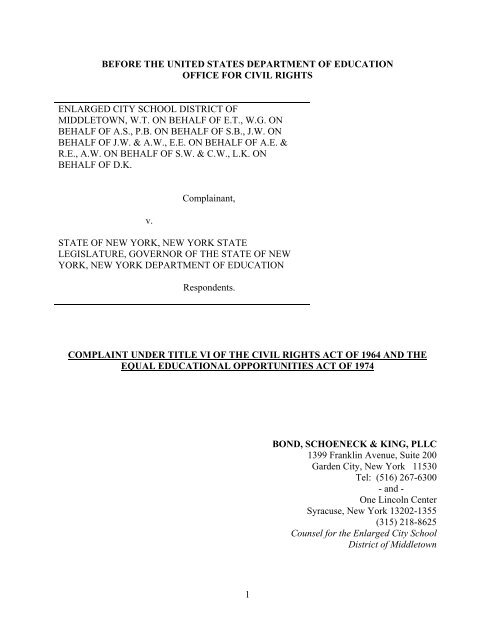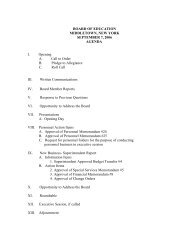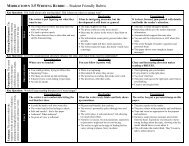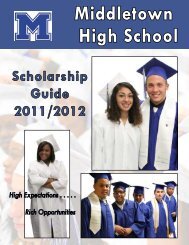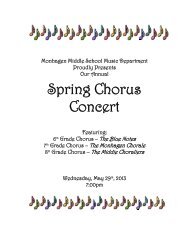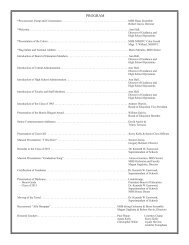1 before the united states department of education office for civil ...
1 before the united states department of education office for civil ...
1 before the united states department of education office for civil ...
You also want an ePaper? Increase the reach of your titles
YUMPU automatically turns print PDFs into web optimized ePapers that Google loves.
were eligible <strong>for</strong> free or reduced price lunch. 3Middletown’s Instructional Expenditure Per Pupilis more than $1000 below similar districts. 4Due to <strong>the</strong> Respondents’ systematic failure toprovide an adequate level <strong>of</strong> state aid, Middletown has been <strong>for</strong>ced to eliminate over 145 staffpositions over <strong>the</strong> past four years.Middletown serves on average 800 ELLs per school year <strong>for</strong> whom it providesspecial <strong>education</strong>al programming. ELLs must remain in Middletown’s special programs until<strong>the</strong>y test as pr<strong>of</strong>icient on <strong>the</strong> New York State English as a Second Language Achievement Test(“NYSESLAT”). Students who are unable to pass <strong>the</strong> NYSESLAT <strong>for</strong> more than 6 years aredesignated “long term LEPs” and must be reported to NYSED.Pursuant to Part 154 <strong>of</strong> <strong>the</strong> Commissioner’s Regulations, all schools receivingFoundation Aid funding from NYSED (described in detail in Section III, supra) must provideEnglish as a Second Language (“ESL”) classes <strong>for</strong> <strong>the</strong>ir ELLs. 8 N.Y.C.R.R. § 154.3.Middletown provides two programs at <strong>the</strong> elementary level <strong>for</strong> its ELLs: (1) an ESL program;and (2) a bilingual program. These programs are supported by 48 certified teachers.ESL classes are taught solely in English by a teacher certified in teaching Englishas a Second Language (“TESOL”). Based on level <strong>of</strong> English pr<strong>of</strong>iciency, Middletown providesELLs with ei<strong>the</strong>r 1, 2, or 3 periods a day <strong>of</strong> ESL instruction. Beginner and intermediate ELLsreceive all English Language Arts (“ELA”) instruction from ESL teachers. Advanced ELLsreceive ELA instruction from <strong>the</strong>ir homeroom teachers, and also receive one period <strong>of</strong>3 New York State Report Card, Middletown City School District, March 25, 2013, available at:https://reportcards.nysed.gov/files/2011-12/RC-2012-441000010000.pdf (hereinafter “Middletown Report Card”), at3.4 New York State School Report Card, Fiscal Accountability Supplement, available at:https://reportcards.nysed.gov/files/2011-12/FIS-2012-441000010000.pdf.5
B. The Individual ComplainantsThe individual complainants are parents whose children attend Middletown’sschools. For <strong>the</strong> children <strong>of</strong> each <strong>of</strong> <strong>the</strong> individual complainants, <strong>the</strong> funding disparity that is <strong>the</strong>subject <strong>of</strong> this Complaint has created, inter alia, larger class sizes; higher student-to-teacherratios; reduced curricula; cuts in and elimination <strong>of</strong> programs and electives and advancedplacement courses; shortages <strong>of</strong> textbooks and resources; shortages <strong>of</strong> technology; insufficientphysical <strong>education</strong> and extracurricular activities; insufficient library resources; and insufficientfacilities.C. The RespondentsRespondents are <strong>the</strong> State <strong>of</strong> New York by and through <strong>the</strong> entities chieflyresponsible <strong>for</strong> <strong>the</strong> allocation and distribution <strong>of</strong> moneys to <strong>the</strong> State’s school districts, includingMiddletown. Those entities include <strong>the</strong> New York State Legislature, <strong>the</strong> Governor <strong>of</strong> <strong>the</strong> State<strong>of</strong> New York, NYSED, New York State Board <strong>of</strong> Regents and New York State Commissioner <strong>of</strong>Education.The Board <strong>of</strong> Regents is responsible <strong>for</strong> <strong>the</strong> general supervision <strong>of</strong> all <strong>education</strong>alactivities within <strong>the</strong> State, presiding over <strong>the</strong> University and NYSED. The Board comprises 17members elected by <strong>the</strong> State Legislature <strong>for</strong> 5 year terms: 1 from each <strong>of</strong> <strong>the</strong> State's 13 judicialdistricts and 4 members who serve at large. 7 The Commissioner <strong>of</strong> Education (currently, Dr.John B. King, Jr.) oversees more than 7,000 public and independent elementary and secondaryschools (serving 3.1 million students), and hundreds <strong>of</strong> o<strong>the</strong>r <strong>education</strong>al institutions across NewYork State including higher <strong>education</strong>, libraries, and museums. The Commissioner holds himselfout as a strong voice <strong>for</strong> <strong>education</strong> re<strong>for</strong>m and a driving <strong>for</strong>ce in New York’s successful Federal7 http://www.regents.nysed.gov/7
Race to <strong>the</strong> Top application. 8The Commissioner is, in effect, New York State’s superintendent<strong>of</strong> schools and reports to <strong>the</strong> Board <strong>of</strong> Regents -- effectively <strong>the</strong> State’s Board <strong>of</strong> Education.NYSED is New York State’s <strong>education</strong> agency. NYSED holds itself out to be one <strong>of</strong> <strong>the</strong> mostcomplete, interconnected systems <strong>of</strong> <strong>education</strong>al services in <strong>the</strong> United States. 9Its statedmission is to raise <strong>the</strong> knowledge, skill, and opportunity <strong>of</strong> all <strong>the</strong> people in New York. NYSED,<strong>the</strong> Board <strong>of</strong> Regents and Commissioner direct where <strong>education</strong>al funds are distributed inaccordance with <strong>education</strong> aid <strong>for</strong>mulas established and approved by <strong>the</strong> New York StateLegislature and Governor.At all times relevant to this Complaint, New York State and NYSED have beensubstantial recipients <strong>of</strong> federal financial assistance. During <strong>the</strong> 2012 and 2013 fiscal years, NewYork State received 1089 federal grants totaling $5.67 billion. 10During <strong>the</strong> 2012 and 2013 fiscalyears, NYSED received 5 federal grants totaling approximately $49.94 million. 11Notably, NewYork State and NYSED were recipients <strong>of</strong> American Recovery and Reinvestment Act funds in2009, and NYSED, as New York’s <strong>education</strong> agency, was responsible <strong>for</strong> distributing <strong>the</strong>sefunds to school districts in New York.III.NEW YORK’S DISCRIMINATORY STATE FUNDINGSTRUCTURESupport <strong>for</strong> public <strong>education</strong> in New York comes from three sources: (1) <strong>the</strong>federal government (approximately 5 percent); (2) state <strong>for</strong>mula aids and grants (approximately40 percent); and (3) revenues raised locally (approximately 55 percent). State aid <strong>for</strong> public8 http://usny.nysed.gov/about/commissioner_king.html9 http://usny.nysed.gov/about/10 U.S. Dep’t <strong>of</strong> Education, Grant Award Pick-List (Search Report), accessed October 2013.11 Id.8
schools comes primarily from <strong>the</strong> State General Fund. 12More than 90 percent <strong>of</strong> <strong>the</strong> variability<strong>of</strong> local revenue in New York school districts is attributable to property taxes, <strong>the</strong> burden <strong>of</strong>which <strong>the</strong> State in large part assumes through <strong>the</strong> School Tax Relief (STAR) program. 13The Laws <strong>of</strong> 2007 consolidated approximately thirty existing aid programs into aFoundation Aid <strong>for</strong>mula that was designed to distribute funds to school districts based on <strong>the</strong>cost <strong>of</strong> providing an adequate <strong>education</strong>, adjusted to reflect regional costs and concentration <strong>of</strong>needy pupils. 14One <strong>of</strong> <strong>the</strong> aid programs that was eliminated in <strong>the</strong> 2007 consolidation was <strong>the</strong>Limited English Pr<strong>of</strong>iciency (“LEP”) aid program, which was <strong>the</strong> principal source <strong>of</strong> funding <strong>for</strong>ELL programming. Pursuant to <strong>the</strong> Foundation Aid <strong>for</strong>mula, needy districts like Middletownwere deemed to require a minimum amount <strong>of</strong> state funding to provide a “sound basic<strong>education</strong>” to all <strong>the</strong>ir students, including ELLs.The 2007-2008 Enacted Budget included a four-year phase-in <strong>of</strong> Foundation Aid.The 2009-2010 Enacted Budget extended <strong>the</strong> phase-in to 2013-2014 and froze 2009-2010 and2010-2011 payable Foundation Aid to 2008-2009 Foundation Aid. The 2011-2012 EnactedBudget extended <strong>the</strong> phase-in to 2016-2017 and froze 2011-2012 payable Foundation Aid to2008-2009 Foundation Aid. The 2012-2013 Enacted Budget provided no phase-in <strong>of</strong> 2013-2014aid except <strong>for</strong> <strong>the</strong> New York City School District at 5.23 percent. 15The effects <strong>of</strong> <strong>the</strong>se freezes on Foundation Aid were compounded by budget cutsin 2009. Pursuant to Section 24 <strong>of</strong> Part A <strong>of</strong> Chapter 57 <strong>of</strong> <strong>the</strong> Laws <strong>of</strong> 2009, New York’s12 New York State Education Department Fiscal Analysis and Research Unit, Primer on State Aid, available athttp://www.oms.nysed.gov/faru/PDFDocuments/Primer13-14B.pdf.13 Baker, B., Corcoran, S., “The Stealth Inequities <strong>of</strong> School Funding: How State and Local School Finance SystemsPerpetuate Inequitable Student Spending,” AmericanProgress.com, Sept. 2012.14 Id.15 Id.9
school districts were assessed a Deficit Reduction Assessment (“DRA”) <strong>of</strong> $2.097 billion toclose New York’s fiscal deficit. 16 Middletown was assessed a $3,024,767 DRA. 17In 2009, New York State received a $2.5 billion State Fiscal Stabilization Fund(“SFSF”) Education Fund grant pursuant to <strong>the</strong> American Recovery and Reinvestment Act(“ARRA”) and NYSED was responsible <strong>for</strong> distributing <strong>the</strong>se funds to school districts in NewYork to close <strong>the</strong> gap created by <strong>the</strong> DRA. 18However, ra<strong>the</strong>r than distributing <strong>the</strong> SFSF fundsaccording to <strong>the</strong> Foundation Aid <strong>for</strong>mula, <strong>the</strong> funds were distributed to return Foundation Aid to<strong>the</strong> “freeze” level across <strong>the</strong> board, and to fund o<strong>the</strong>r school expense-driven aids at higher levels.Since 2007, New York State has gradually adjusted <strong>the</strong> Foundation Aid <strong>for</strong>mulato provide more state funding to low poverty districts and less state funding to high povertydistricts. 19The effects <strong>of</strong> <strong>the</strong>se adjustments have been exacerbated by <strong>the</strong> State’s STAR aid<strong>for</strong>mula, which has enhanced <strong>the</strong> state aid provided to affluent districts by a considerablemargin. 20Toge<strong>the</strong>r, <strong>the</strong> Foundation Aid freezes, NYSED’s distribution <strong>of</strong> SFSF funds, persistentstate aid cuts, and <strong>the</strong> inequitable STAR aid <strong>for</strong>mula have undermined <strong>the</strong> purpose <strong>of</strong> <strong>the</strong>Foundation Aid <strong>for</strong>mula <strong>of</strong> prioritizing funding to needy school districts, and instead resulted in<strong>the</strong> neediest school districts receiving a much smaller percentage <strong>of</strong> <strong>the</strong> Foundation Aid <strong>the</strong>y16 New York State Education Department, Deficit Reduction Assessment Restoration by District, available athttps://stateaid.nysed.gov/budget/html_docs/dra_restoration.htm17 Id.18 New York State Monitoring Plan and Protocols For <strong>the</strong> State Fiscal Stabilization Education and O<strong>the</strong>rGovernment Services Fund, available at http://usny.nysed.gov/arra/monitoringauditing/documents/NewYorkState_SFSF_MonitoringPlan.pdf.19 Baker, Bruce, “School Funding Fairness in New York State,” prepared on behalf <strong>of</strong> <strong>the</strong> New York StateAssociation <strong>of</strong> Small City School Districts, Oct. 1, 2011.20 Id. at 22.10
In short, <strong>the</strong> whiter a school district’s population, <strong>the</strong> more likely <strong>the</strong> district isreceiving full or close to full funding. A “minority-as-majority” district is three times as likely tobe underfunded as a predominantly white district.14
Middletown, a “minority-as-majority” school district in New York, has beenharmed by New York’s racially discriminatory funding practices. Approximately 77 percent <strong>of</strong>Middletown’s student population is non-white, and Middletown receives only 56 percent <strong>of</strong> <strong>the</strong>Foundation Aid funding to which it is entitled.15
IV.ARGUMENTA. The State’s Distribution Of Foundation Aid DisparatelyImpacts New York Students On The Basis Of Race.Title VI prohibits discrimination on <strong>the</strong> basis <strong>of</strong> race, color, or national origin inprograms and activities receiving Federal financial assistance. Specifically, Title VI providesthat:[n]o person in <strong>the</strong> United States shall, on <strong>the</strong> ground <strong>of</strong> race, color,or national origin, be excluded from participation in, be denied <strong>the</strong>benefits <strong>of</strong>, or be subjected to discrimination under any program oractivity receiving Federal financial assistance.Title VI, § 601; 42 U.S.C. § 2000d. The United States Supreme Court has held that Section 601only prohibits intentional discrimination. See Guardians Ass’n v. Civil Serv. Comm’n, 463 U.S.582 (1983). However, Section 602 “authorize[s] and direct[s]” federal financial assistance toparticular programs or activities “to effectuate <strong>the</strong> provisions <strong>of</strong> Section 601 . . . by issuing rules,17
egulations, or orders <strong>of</strong> general applicability.” 42 U.S.C. § 200d. At least 40 federal agencieshave adopted regulations that prohibit disparate-impact discrimination pursuant to this authority.See Guardians, 463 U.S. at 619 (Marshall, J. dissenting). Department <strong>of</strong> Education regulationsstate:A recipient, in determining <strong>the</strong> types <strong>of</strong> services, financial aid, oro<strong>the</strong>r benefits, or facilities which will be provided under any suchprogram, or <strong>the</strong> class <strong>of</strong> individuals to whom, or <strong>the</strong> situations inwhich, such services, financial aid, o<strong>the</strong>r benefits, or facilities willbe provided under any such program, or <strong>the</strong> class <strong>of</strong> individuals tobe af<strong>for</strong>ded an opportunity to participate in any such program, maynot, directly or through contractual or o<strong>the</strong>r arrangements, utilizecriteria or methods <strong>of</strong> administration which have <strong>the</strong> effect <strong>of</strong>subjecting individuals to discrimination because <strong>of</strong> <strong>the</strong>ir race,color, or national origin, or have <strong>the</strong> effect <strong>of</strong> defeating orsubstantially impairing accomplishment <strong>of</strong> <strong>the</strong> objectives <strong>of</strong> <strong>the</strong>program as respect individuals <strong>of</strong> a particular race, color, ornational origin.”34 C.F.R. § 100.3(b) (emphasis added). Pursuant to such regulations, all entities that receivefederal funding, including New York State and NYSED, enter into standard agreements orprovide assurances that require certification that <strong>the</strong> recipients will comply with <strong>the</strong>implementing regulations under Title VI. Guardians, 463 U.S. 582, 642 n.13. The SupremeCourt has held that <strong>the</strong>se regulations may validly prohibit practices having a disparate impact onprotected groups, even if <strong>the</strong> actions or practices are not intentionally discriminatory. Id;Alexander v. Choate, supra; see also Villanueva v. Carere, 85 F.3d 481 (10th Cir. 1996); NewYork Urban League v. New York, 71 F.3d 1031, 1036 (2d Cir. 1995); Chicago v. Lindley, 66 F.3d819 (7th Cir. 1995); David K. v. Lane, 839 F.2d 1265 (7th Cir. 1988); Gomez v. Illinois State Bd.Of Educ., 811 F.2d 1030 (7th Cir. 1987); Georgia State Conf. v. Georgia, 775 F.2d 1403 (11thCir. 1985); Larry P. v. Riles, 793 F.2d 969 (9th Cir. 1984).18
A recipient’s practices have a racially discriminatory impact if <strong>the</strong>y have adisproportionate impact on a group protected by Title VI. Lau v. Nichols, 414 U.S. 563 at 568(1974). Disparate impact violations occur where recipients utilize policies or practices that resultin <strong>the</strong> provision <strong>of</strong> fewer services or benefits, or inferior services or benefits, to members <strong>of</strong> aprotected group. See Meek v. Martinez, 724 F. Supp. 888 (S.D.Fla. 1987) (Florida’s use <strong>of</strong>funding <strong>for</strong>mula in distributing aid resulted in a substantially adverse disparate impact onminorities and <strong>the</strong> elderly); see also Campaign <strong>for</strong> Fiscal Equity, Inc. v. State <strong>of</strong> New York, 86N.Y.2d 307, 655 N.E.2d 1178 (N.Y. Ct. App. Jun 15, 1995) (prima facie case established whereallocation <strong>of</strong> <strong>education</strong>al aid had a racially disparate impact); see Robinson v. Kansas, 295 F.3d1183 (10th Cir. 2002) (finding state and its <strong>education</strong> <strong>of</strong>ficials did not enjoy sovereign immunity<strong>for</strong> claim based on “Kansas’ state school financing system [which,] through a provision <strong>for</strong> ‘lowenrollment weighting’ and ‘local option budgets,’ allegedly resulted in less funding per pupil inschools where minority students, students who were not <strong>of</strong> United States origin, and studentswith disabilities [were] disproportionately enrolled.”); Powell v. Ridge, 189 F.3d 387 (3d Cir.1999) (reversing dismissal and finding that complaint alleging that school districts with higherproportions <strong>of</strong> nonwhite students received less Commonwealth treasury revenues than districtswith higher proportions <strong>of</strong> white students stated a claim <strong>for</strong> disparate impact under Title VI).Claims <strong>of</strong> disparate impact under Title VI must necessarily rely on statisticalpro<strong>of</strong>. See Watson v. Fort Worth Bank and Trust, 487 U.S. 977, 987 (1988). However, becausestatistical analysis can never scientifically prove discrimination, courts have held that a plaintiffmay establish a prima facie case <strong>of</strong> disparate impact discrimination by pr<strong>of</strong>fering statisticalevidence which reveals a disparity substantial enough to raise an inference <strong>of</strong> causation. EEOCv. Joint Apprenticeship Committee <strong>of</strong> Joint Industry Bd. <strong>of</strong> Elec. Indus., 186 F.3d 110, 117 (2d19
Cir. 1999) (quoting Bazemore v. Friday, 478 U.S. 385, 400 (1986) and Bridgeport Guardians,Inc. v. City <strong>of</strong> Bridgeport, 933 F.2d 1140, 1146 (2d Cir. 1991)).There is no question that <strong>the</strong> State <strong>of</strong> New York and its Education Department are“recipients” <strong>of</strong> federal funding <strong>for</strong> purposes <strong>of</strong> federal <strong>civil</strong> rights laws. New York has promisedits school districts a minimum amount <strong>of</strong> state aid in order to ensure that each district is able toprovide basic instruction to its students. Currently, however, <strong>the</strong> likelihood that a school districtis receiving <strong>the</strong> full measure <strong>of</strong> state <strong>education</strong>al aid that it has been promised, and consequently,<strong>the</strong> likelihood that <strong>the</strong> district is adequately funded, is heavily impacted by whe<strong>the</strong>r <strong>the</strong> districtserves predominantly white students. The disparity between <strong>the</strong> percentage <strong>of</strong> required aidreceived by predominantly white districts and <strong>the</strong> percentage received by “minority-as-majority”districts is too significant to be coincidental, and too inequitable to be supported by a “legitimatejustification.” The State’s maintenance <strong>of</strong> this funding structure, which has <strong>the</strong> effect <strong>of</strong>discriminating against students on <strong>the</strong> basis <strong>of</strong> race, violates Title VI.This inequitable distribution <strong>of</strong> aid has had a <strong>for</strong>eseeable negative impact onpredominantly minority school districts, like Middletown. The <strong>education</strong>al opportunities <strong>for</strong>Middletown’s students have been seriously impaired by <strong>the</strong> State’s failure to adequately fundminority-as-majority districts. The funding disparity has created, inter alia: larger class sizes and higher student-to-teacher ratios; reduced curricula; cuts in and elimination <strong>of</strong> programs and electives and advanced placementcourses; shortages <strong>of</strong> textbooks and resources; shortages <strong>of</strong> technology;20
insufficient physical <strong>education</strong> and extracurricular activities; insufficient library resources; insufficient facilities.The practical and actual effect <strong>of</strong> <strong>the</strong> State’s distribution <strong>of</strong> Foundation Aid has been to create apublic <strong>education</strong> system where <strong>the</strong> whiter a school district’s population, <strong>the</strong> more likely <strong>the</strong>district is receiving full or close to <strong>the</strong> full funding it has been promised. The State’s failure tomeet its Foundation Aid goals thus disproportionately and unlawfully impacts minority students,including <strong>the</strong> minority students enrolled in Middletown. As a public entity and a recipient <strong>of</strong>federal assistance, New York State is responsible <strong>for</strong> ensuring that its methods <strong>of</strong> distributing aiddo not adversely and disparately impact minorities. It has failed to do so.B. The State’s Distribution Of Foundation Aid ImpermissiblyDenies Equal Educational Opportunity To New York’sStudents Based On National Origin.The relevant portions <strong>of</strong> <strong>the</strong> EEOA provide:No State shall deny equal <strong>education</strong>al opportunity to an individualon account <strong>of</strong> his or her race, color, sex, or national origin, by . . .(f) <strong>the</strong> failure by an <strong>education</strong>al agency to take appropriate actionto overcome language barriers that impede equal participation byits students in its instructional programs.20 U.S.C. § 1703. “This provision <strong>of</strong> <strong>the</strong> EEOA was intended to remedy <strong>the</strong> linguisticdiscrimination identified by Lau v. Nichols, 414 U.S. 563, 94 S. Ct. 786, 39 L. Ed. 2d 1 (1974),in which <strong>the</strong> Supreme Court held that failing to provide <strong>for</strong> <strong>the</strong> needs <strong>of</strong> non-English speakingstudents ‘make[s] a mockery <strong>of</strong> public <strong>education</strong>,’ rendering classroom experiences <strong>for</strong> <strong>the</strong>sechildren ‘wholly incomprehensible and in no way meaningful.’” Flores v. State <strong>of</strong> Arizona, 516F.3d 1140, 1146 (9th Cir. 2008). In Flores, <strong>the</strong> District <strong>of</strong> Arizona held that Arizona’s funding<strong>for</strong> ELL students did not cover <strong>the</strong> incremental costs <strong>of</strong> ELL programming, and consequently21
that <strong>the</strong> “minimum base level <strong>for</strong> funding [ELL] programs [was] arbitrary and capricious and[bore] no relation to <strong>the</strong> actual funding needed to ensure that [ELL] students are achievingmastery <strong>of</strong> [<strong>the</strong> State’s] specified ‘essential skills.’” Flores II, 172 F. Supp. 2d at 1239. Thecourt held that “Arizona had, <strong>the</strong>re<strong>for</strong>e, failed to follow through with . . . resources . . . necessaryto trans<strong>for</strong>m <strong>the</strong>ory into reality.” Id. at 1239.Subsequently, Arizona moved <strong>for</strong> relief from <strong>the</strong> district court’s judgment. Thedistrict court denied relief. Flores v. Arizona, 480 F. Supp. 2d 1157, 1167 (D. Ariz. 2007). TheNinth Circuit affirmed, rejecting <strong>the</strong> State’s argument that compliance with <strong>the</strong> standards in NoChild Left Behind satisfied <strong>the</strong> State’s obligations vis a vis <strong>the</strong> EEOA. Flores v. State <strong>of</strong>Arizona, 516 F.3d 1140, 1146 (9th Cir. 2008). In affirming <strong>the</strong> denial <strong>of</strong> relief, <strong>the</strong> Ninth Circuitreiterated that “ELL students need extra help and that costs extra money.” Id. at 1167.Determining whe<strong>the</strong>r a state has violated <strong>the</strong> EEOA is a three-step inquiry.Castaneda v. Pickard, 648 F.2d 989, 1009-10 (5th Cir. 1981); see also Gomez v. Illinois StateBd. <strong>of</strong> Educ., 811 F.2d 1030, 1041-42 (7th Cir. 1987) (applying <strong>the</strong> Castaneda analysis); Flores,516 F.3d at 1146. First, courts must be satisfied that <strong>the</strong> “school system is purs[uing] a programin<strong>for</strong>med by an <strong>education</strong>al <strong>the</strong>ory recognized as sound by some experts in <strong>the</strong> field or, at least,deemed a legitimate experimental strategy.” Castaneda, 648 F.2d at 1009. Second, “<strong>the</strong>programs and practices actually used by a school system [must be] reasonably calculated toimplement effectively <strong>the</strong> <strong>education</strong>al <strong>the</strong>ory adopted by <strong>the</strong> school.” Id. at 1010. There must, ino<strong>the</strong>r words, be sufficient “practices, resources and personnel . . . to trans<strong>for</strong>m <strong>the</strong> <strong>the</strong>ory intoreality.” Id. Third, even if <strong>the</strong>ory is sound and resources are adequate, <strong>the</strong> program must beborne out by practical results. Id. The Attorney General <strong>of</strong> <strong>the</strong> United States, <strong>for</strong> or in <strong>the</strong> name22
<strong>of</strong> <strong>the</strong> United States, may institute a <strong>civil</strong> action on behalf <strong>of</strong> individuals denied equal <strong>education</strong>alopportunities. 20 U.S.C. § 1706.In addition to being racially discriminatory, New York State’s inequitabledistribution <strong>of</strong> Foundation Aid discriminates against New York’s ELL students. New York hasmore than 315,000 ELLs in its public schools. Prior to New York’s implementation <strong>of</strong> <strong>the</strong>common core curriculum in 2012, only 11.7 percent <strong>of</strong> ELL students in grades 3 -8 werepr<strong>of</strong>icient in ELA, and only 34.4 percent were pr<strong>of</strong>icient in math.The results <strong>of</strong> New York’s new common-core-aligned tests, administered at <strong>the</strong>end <strong>of</strong> <strong>the</strong> 2012-2013 school year, revealed far greater inadequacies in ELL per<strong>for</strong>mance: only3.2 percent <strong>of</strong> ELL students scored in <strong>the</strong> pr<strong>of</strong>icient range <strong>for</strong> ELA and only 9.8 scored in <strong>the</strong>pr<strong>of</strong>icient range <strong>for</strong> math. 23New York’s high-need districts simply do not have <strong>the</strong> resources<strong>the</strong>y need to give <strong>the</strong>ir ELLs even a chance <strong>of</strong> meeting <strong>the</strong> State’s rigorous new standards. Forexample: in <strong>the</strong> Amityville Union Free School District (92 percent non-white, 14percent ELL, and 64 percent eligible <strong>for</strong> free or reduced price lunch), over88 percent <strong>of</strong> students failed to achieve pr<strong>of</strong>iciency in Math and over 85percent failed to achieve pr<strong>of</strong>iciency in ELA. in <strong>the</strong> Freeport Union Free School District (91 percent non-white, 16percent ELL, and 54 percent eligible <strong>for</strong> free or reduced price lunch), over23 See Waldman, Scott, “Bar lifts, scores fall,” Timesunion.com, http://www.timesunion.com/local/article/Bar-liftsscores-fall-4714067.php#page-2(Aug. 8, 2013); Maxwell, Leslie, “A Look at ELL Per<strong>for</strong>mance So Far onCommon-Core-Aligned Tests,” Education Week, http://blogs.edweek.org/edweek/learning-<strong>the</strong>language/2013/08/ell_per<strong>for</strong>mance_sinks_on_commo.html?utm_source=feedburner&utm_medium=email&utm_cacampai=Feed%3A+LearningTheLanguage+%28Education+Week+Blog%3A+Learning+<strong>the</strong>+Language%29 (Aug. 9,2013).23
82 percent <strong>of</strong> students failed to achieve pr<strong>of</strong>iciency in Math and over 78percent failed to achieve pr<strong>of</strong>iciency in ELA. in <strong>the</strong> Central Islip Union Free District (92 percent non-white, 26 percentELL, and 83 percent eligible <strong>for</strong> free or reduced price lunch), over 91percent failed to achieve pr<strong>of</strong>iciency in Math and over 88 percent failed toachieve pr<strong>of</strong>iciency in ELA. 24Middletown’s ELL achievement numbers were similar to <strong>the</strong>se high-need,underfunded districts: 2 percent <strong>of</strong> Middletown’s ELL students scored in <strong>the</strong> pr<strong>of</strong>icient range <strong>for</strong>ELL, and 2 percent scored in <strong>the</strong> pr<strong>of</strong>icient range <strong>for</strong> math.Despite Middletown’s ardent ef<strong>for</strong>ts to defeat linguistic barriers, <strong>the</strong> State’sfailure to equitably distribute Foundation Aid has had tangible deleterious effects onMiddletown’s ELLs. Like many o<strong>the</strong>r high-need school districts, none <strong>of</strong> Middletown’s ELLsgraduated with advanced designation diplomas, <strong>the</strong> State’s measure <strong>of</strong> college and careerreadiness, in <strong>the</strong> 2012 or 2013 school years. 25The State’s inequitable distribution <strong>of</strong> FoundationAid has created serious and insurmountable barriers to Middletown’s ability to meet <strong>the</strong> needs <strong>of</strong>its ELLs, including:<strong>the</strong> inability to provide bilingual special <strong>education</strong> classes.understaffing, resulting in bilingual classes with high pupil to teacherratios and insufficient pull-out ESL servicesinsufficient Academic Intervention Servicesinsufficient teaching materials <strong>for</strong> both ESL and content areas24 See https://reportcards.nysed.gov/25 See Press Release,http://www.oms.nysed.gov/press/GraduationRates2012OverallImproveSlightlyButStillTooLow.html, accessedOctober 2013.24
The cost <strong>of</strong> ELL instruction that complies with constitutional mandates farexceeds <strong>the</strong> only financial assistance <strong>the</strong> State provides school districts <strong>for</strong> such purposes. NewYork, through its inequitable distribution <strong>of</strong> Foundation Aid, has failed to devote sufficient“practices, resources and personnel” to ensure that ELLs in low-wealth districts like Middletownmake meaningful academic progress, or “trans<strong>for</strong>m <strong>the</strong>ory into reality.” The State’s recentassessments demonstrate that low-wealth districts like Middletown simply do not have <strong>the</strong>resources to ensure that <strong>the</strong>ir programs “bear out practical results” <strong>for</strong> <strong>the</strong>ir most vulnerablestudents. Castaneda, 648 F.2d at 1009. New York’s inequitable funding structure has severelycompromised Middletown’s ability to provide <strong>for</strong> <strong>the</strong> needs <strong>of</strong> its non-English speaking students.This linguistic discrimination violates <strong>the</strong> EEOA.V. CONCLUSIONFor <strong>the</strong> above-stated reasons, <strong>the</strong> Department <strong>of</strong> Education should fullyinvestigate this Complaint and direct <strong>the</strong> Respondents to: (1) discontinue or remedy <strong>the</strong>irinequitable, racially discriminatory methods <strong>of</strong> funding public <strong>education</strong> in New York; and (2)provide adequate funds to local school districts to enable <strong>the</strong>m to remove barriers to participationin <strong>education</strong>al programs <strong>for</strong> ELL students.25
Dated: Garden City, New YorkSyracuse, New YorkDecember 13, 2013Respectfully submitted,BOND, SCHOENECK & KING, PLLCBy:________________________Howard M. MillerKate I. ReidAttorneys <strong>for</strong> <strong>the</strong> Enlarged City SchoolDistrict <strong>of</strong> Middletown1399 Franklin AvenueGarden City, New York 11530(516) 267-6300-and-One Lincoln CenterSyracuse, New York 13202-1355(315) 218-862526


